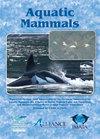Northern Range Expansion of California Coastal Bottlenose Dolphins (Tursiops truncatus)
IF 0.9
4区 生物学
Q4 MARINE & FRESHWATER BIOLOGY
引用次数: 1
Abstract
The California coastal stock of bottlenose dolphins (Tursiops truncatus) expanded its range north from the Southern California Bight, its historical range, into Central California coincident with the 1982-1983 El Niño event. Since the late 1980s, bottlenose dolphin sightings north of Central California have been increasingly reported. To determine the present-day northern range limit for these dolphins, photo-identification efforts were carried out from 2007 to 2018 in San Francisco Bay and nearby coastal waters during which 84 individuals were identified. The results demonstrate a significant range expansion along the Northern California coast at least as far as Sonoma County (38.7º N). Comparisons with photo-identification catalogs compiled south of San Francisco from 1981 to 2015 revealed that 92% of the 84 dolphins were matched to Monterey Bay (n = 77), Santa Barbara (n = 27), Santa Monica Bay (n = 29), Orange County (n = 9), Corona Del Mar (n = 2), San Diego (n = 31), and Ensenada, Mexico (n = 1). Many of the 84 dolphins (54%) showed long-range movements across the stock’s range between the Southern California Bight and the San Francisco Bay Area. The greatest movement distance recorded was by two individuals first observed in San Diego, California, in the 1980s and subsequently in Puget Sound, Washington (47º N), in 2017, setting a coastal bottlenose dolphin long-distance movement record of at least 2,500 km.加利福尼亚沿海宽吻海豚(Tursiops truncatus)的北部范围扩张
加利福尼亚海岸宽吻海豚(Tursiops truncatus)的种群从其历史范围的南加州湾向北扩展到加利福尼亚中部,与1982-1983年的El Niño事件一致。自20世纪80年代末以来,在加州中部北部看到宽吻海豚的报道越来越多。为了确定这些海豚目前的北部活动范围,从2007年到2018年,在旧金山湾和附近的沿海水域进行了照片识别工作,其间识别了84只海豚。结果表明,北加州海岸的范围显著扩大,至少远至索诺玛县(38.7ºN)。与1981年至2015年在旧金山以南编制的照片识别目录进行比较,发现84只海豚中有92%与蒙特利湾(N = 77)、圣巴巴拉(N = 27)、圣莫尼卡湾(N = 29)、奥兰奥兰县(N = 9)、科罗纳德尔马(N = 2)、圣地亚哥(N = 31)和恩塞纳达相匹配。墨西哥(n = 1)。84只海豚中有许多(54%)在南加州湾和旧金山湾区之间的种群范围内进行了长距离运动。记录的最大移动距离是20世纪80年代在加利福尼亚州圣地亚哥首次观察到的两只个体,随后于2017年在华盛顿州的普吉特海湾(47ºN)观察到,创造了至少2500公里的沿海宽吻海豚长距离移动记录。
本文章由计算机程序翻译,如有差异,请以英文原文为准。
求助全文
约1分钟内获得全文
求助全文
来源期刊

Aquatic Mammals
MARINE & FRESHWATER BIOLOGY-ZOOLOGY
CiteScore
1.60
自引率
16.70%
发文量
99
审稿时长
>12 weeks
期刊介绍:
Aquatic Mammals is a peer-reviewed journal sponsored by the European Association for Aquatic Mammals (EAAM), the Alliance of Marine Mammal Parks and Aquariums (AMMPA), and the International Marine Animal Trainers’ Association (IMATA). Aquatic Mammals publishes articles related to marine mammals (whales, dolphins, seals, fur seals, sea lions, walrus, dugongs, manatees, sea otters, and polar bears). Topics of publication on both captive animals and wild marine mammals include aspects of husbandry; behavior; conservation; veterinary medicine; anatomy; physiology; training; population trends; and the effects of pollution, climate change, and noise.
 求助内容:
求助内容: 应助结果提醒方式:
应助结果提醒方式:


